
What We Can Do!
Our 2020 Climate Action Workshops are complete. Below, in Section 1, are Lessons your neighbors have learned from their solar installations. And following that in Section 2 are summaries — including video links — to the workshops (1 Actions Being Taken Now; 2 Getting More Energy Efficient; 3 Adding Renewables). Section 3 below has getting started tips.
We anticipate another Solar Group Buy opportunity being offered in 2021. Will keep you informed.
Supporters: Town of Vermont *** Dane County Office of Energy & Climate ***Gateway to the Driftless ***Black Earth Creek Watershed Association *** Legacy Solar Cooperative *** Town of Cross Plains *** Wisconsin Focus on Energy *** Cross Plains Sustainability Committee *** Town of Middleton
SECTION 1: “WHAT I HAVE LEARNED ABOUT SOLAR“
GROUND MOUNT SOLAR PV
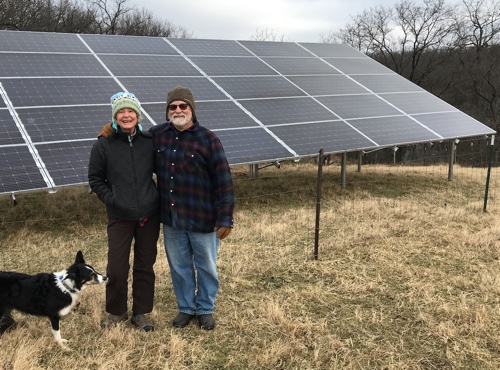
Trisha McConnell and Jim Billings/County F
System: 11.1 kW solar PV, 30 panels, ground mounted; Philadelphia Solar PS-M72, Fronius Primo 12.5-1 Inverter. No battery storage.
Installed by: All Sky Solar, Baraboo, Oct. 2020.
Utility provider: Black Earth Utility/Vanguard.
Willing to be contacted to learn more? Yes, at jamesbillings48@yahoo.com
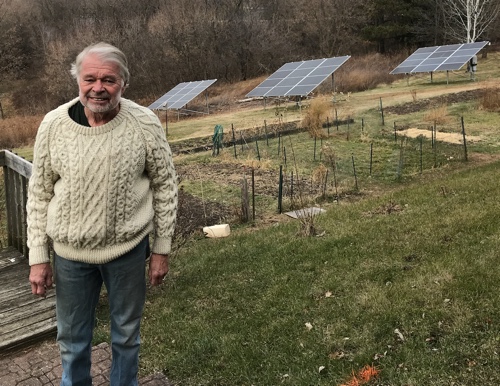
Michael McDermott and Charlene Taymor/Blue Mounds Trail
System: 13.2 kW solar PV, 36 panels, ground mounted; Philadelphia Solar PS-M72, Fronius Primo 12.5-1 Inverter. No battery storage.
Installed by: All Sky Solar, Baraboo, Dec. 2020.
Utility provider: Black Earth Utility/Vanguard.
What would you have done differently: Installed 1 or 2 years earlier.
Willing to be contacted to learn more? Yes, at mmcdermott75@outlook.com
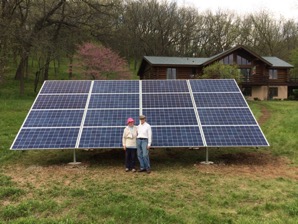
Fred Townsend and Barbara Borns/Union Valley Road
System: 6.8 kW solar PV, 16 panels, ground mounted; SolarEdge/5000A panels and inverter. No battery storage.
Installed by: Drews Solar, Madison, May 2017.
Utility provider: Black Earth Utility/Vanguard.
Lessons learned: If you have the space, a ground mount system allows for easier access to remove snow in winter.
Key positives:Ease of the process.
Willing to be contacted to learn more? Yes, at fredet@tds.net
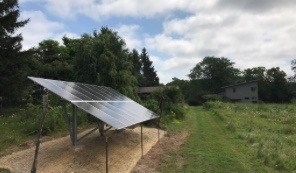
Warren and Sharon Gaskill/Bell Road
System: 5.5 kW Solar PV, 16 panels, ground mounted; SolarWorld 345W XL panels; SolarEdge SE-5000 inverter.
Installed by: Safer Better World Solar, Waunakee, July 2017
Connected to a battery? We had our electric panel rewired as a part of the installation, and have space and a sub panel for a battery, but have not installed yet. Price of battery storage still keeps dropping while quality improving!
Utility provider: Alliant, which nets the production and cost monthly and only pays a wholesale rate for any excess production to the grid.
Key positives: The $2000 Focus on Energy Rebate and the 30% federal tax credit helped a lot in our financing. Given existing electric rates, the breakeven point was forecast for 13 years from install. In the first two years, production has slightly exceeding what was forecast.
Anything different: When we were digging the trench between the solar installation and the electric panel and utility meter at our house, we should have also run a 220-volt line into our garage for a future car changing outlet.
Willing to be contacted to learn more? Yes, at wgaskill@mac.com
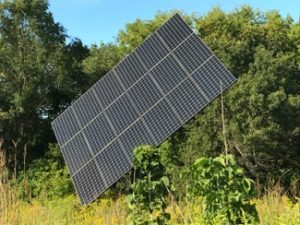
Brian Evans and Agnes Kanikula/County JJ
System: 5.7 kW solar PV, ground mounted/tracking. 18 Sunpower 320 W panels, Fronius IG Inverter, no battery storage.
Installed by: Full Spectrum Solar, October, 2011.
Utility provider: Alliant.
Lessons learned: Tracking collectors provide more electricity for the same number of panels, but they do require additional maintenance. They are great if you like messing about with mechanical things, not so great if you don’t.
Key positives: We have a eGauge monitoring systemwhich is very useful for tracking energy use, power production, etc.
Anything different: Set up for battery backup. It wasn’t practical at the time we installed our system.
Willing to be contacted to learn more? Yes, at brian@housewrights.com
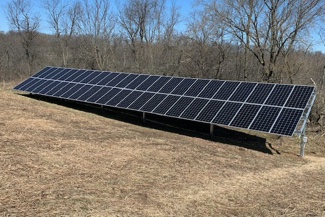
Andy and Karen Grimmer/Kelliher Road
System: 17.28 kW Solar PV, 48 panels ground mounted with annual production estimated at 23,251 kWh. PV Panels: 48 x Heliene, Model: 72M360; Inverters: 2 x SolarEdge Technologies, Model: SE7600H-US (240); no storage at this time.
Installed by: October 2019 by Full Spectrum Solar, Madison.
Utility provider: Mount Horeb.
Key positives: 1) Full Spectrum provided detailed site evaluation and payback study at no cost (provided as selling services). 2) Some tax incentive end or roll back at the end of this year. 3) Even with at 17 kW system, getting to breakeven on usage vs. generation with take lots of additional conservation measures by us. 4) Having the installation planned has motivated me to find and buy the right plug in hybrid or EV.
Anything different: Make this project a priority over some other projects we have going on at our house.
Willing to be contacted to learn more? Yes, at andygrimmer1010@gmail.comor 416-9042.
Jon Norris and Caron Sutterlin/Thumper Road
System: 16.7 kW Solar PV, 40 305-watt Mission panels, ground mounted with adjustability. Fronius inverter. Option for storage.
Installed: July 2019 by Timmermans Talents, Platteville.
Utility provider: Mount Horeb.
Key positives: We have a Wi-Fi connection that enables us to watch production, and the meter also provides feedback
Willing to be contacted to learn more? Yes, at norrisjon25@gmail.com
ROOF MOUNT SOLAR PV
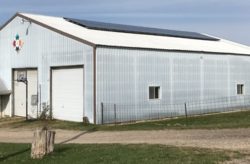
Bil Adler & Gail Piersen/Carter Road
System: 9kW Solar PV, 36 Kyocera 250 watt panels and Fronius inverter ; No storage at this time.
Installed by: June 2015 by H&H Solar Services, now commercial installs only, Madison.
Utility provider: Black Earth Utilities.
Key positives: Glad we installed when we did. Not happy with the $19/month base charge.
Anything different: I would have put the panels on the ground. In the winter, the snow always seems to blow over the ridge from the NW and pile up on the panels.
Willing to be contacted to learn more? Yes, at mudnest2003@yahoo.com.
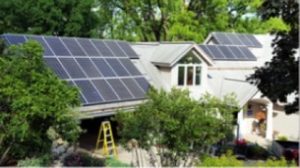
David and Sandie Stanfield/Stanfield Road
System: 9.6 kW Solar PV, 32 panels, roof mounted; Solar World panels and Solar Edge inverter.
Installed by: Midwest Solar Power, Madison, June 2016.
Utility provider: Black Earth Electric, a municipal utility owned by the Village of Black Earth which buys electricity wholesale from Alliant. Black Earth Electric and Mazomanie Electric together contract with Vanguard Electric for maintenance of the utilities’ substations and distribution grid to its customers.
For solar customers, Black Earth Electric installs a meter at our home to measure our solar production and what grid electricity we buy from them. The difference between the two meter readings on a monthly basis results in either a credit or a debit. If we consume more than we produce in any month, we pay that amount; if we produce more than we consume (+ the monthly fixed charges), we pay nothing to Black Earth Electric for that month.
Key positives: In a little more than three years, our solar system produced 33,650 kWh of electricity. For most of those three years, the cost of electricity charged by Black Earth Utility has been $0.111 per kWh, including taxes, but excluding the fixed monthly charges. The cost has increased since July to $0.12 per kWh, and the monthly fixed charges have also increased.
Solar Edge in its estimate of “lifetime revenue” uses the $0.12 per kWh to produce its estimate of the total value of the electricity produced by our system to be $4,038 as of August 12, 2019 (a little more than 3 years). Using that figure, our system should produce approximately what it cost us to install it (net the federal income tax credit and payment from Focus on Energy) in about 12 years.
Anything different: We should have taken the energy efficiency measures before sizing out solar system.To decide to install 32 panels in 2016, we added up our monthly kWh consumption for the year 2015, and multiplied by 80% since we did not want to produce more electricity than we consume. However, this past year — after replacing some inefficient appliances and after turning off cattle and chicken heaters when temperatures were above 30 degrees F, and unplugging our roof edge heaters when the roof was clear of snow — we started to produce more electricity than we consumed.
Willing to be contacted to share experience? Yes, at jdstanfi@wisc.edu
Myles O’Kelly and Terri Niemczyk/ Bakken-Stenli Road
System: 5.7 kW solar PV, 20 panels, roof mounted; Solar World panels, SolarEdge inverter and DC optimizers. No battery storage.
Installed by: H&H Solar, Madison, July 2015.
Utility provider: Alliant.
Lessons learned: Snow sticks and roof treacherous, so consider ground mount to remove snow easily, avoid future re-roofing removal, reduce chance of squirrels camping under panels and chewing power cables.
Key positives: Process was positively simple. It’s always comforting to look up during daylight and know I’m providing myself with energy.
Anything different: Identify ground mount location. Choose different contractor, probably Tim Dyer at Safer Better World in Waunakee.
Willing to be contacted to learn more? Yes, at 767-2330.
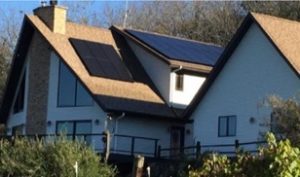
Mark Pocan and Phil Frank/ Bakken-Stenli Road
System: 8.55 kW solar PV, 30 panels, roof mounted; Solar Edge inverter. Have option for onsite battery. (Still very expensive, but having a system that would let you use one in the future is a good idea.)
Installed by: Safer Better World, Waunakee, Oct. 2016.
Utility provider: Alliant.
Lessons learned: Unfortunately, state law disincentives overproduction by paying you the WHOLESALE rate (about 1/4 the rate they charge) for unused energy. That makes a disincentive to produce more than a solar company recommends. We were VERY happy with the company we used, Safer Better World.
Key positives: The Federal Tax Credit is going away soon, but that was very helpful. It is at 30% in 2019, but starts to go down in the next few years. Also, Focus on Energy has a credit to help any purchase.
Anything different: Might have considered stand-alone solar rather than rooftop due to snow. Lose a few days here and there in Winter due to snow coverage.
Willing to be contacted to learn more? Yes, at markpocan@tds.net

Dave and Barb Perkins/ County FF
System: 23.4 kW solar PV, roof mounted. 72 Solar World panels, Fronius Primo inverters. No battery storage.
Installed by: H&H Solar, Madison, April 2016.
Utility provider: Black Earth Electric.
Lessons learned: The installation will pay for itself and much more. In the hills of Vermont township, think about location for maximum sun exposure. You want to setup a system that produces slightly less energy than than your anticipated usage.
Key positives: Good investment. It just works; no moving parts.
Anything different: We did the installation for the farm business, so did not hook up to the house. We should have connected it all. We cannot remove the snow; would consider a placement that would facilitate that. Lost one month to snow last winter.
Willing to be contacted to learn more? Yes, david@vermontvalley.com.
MULTIPLE – WIND, PV, PROPANE, BATTERY OR HOT WATER
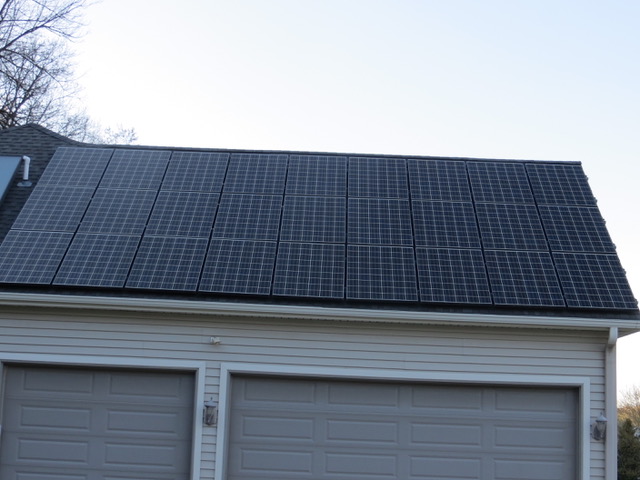
Lee and Marian Sorensen/Gils Way, Cross Plains
System Type and Size: We have a 27-panel, 5 kW PV system and a 65-gallon hot water system with a 65-gallon intermediate storage tank that feeds into the main gas water heater. Both are roof mounted
Manufacturer of panels/ inverter: The panels are Kyocera. The system originally had two Sunnyboy inverters, a 2kW and a 3 kW, because a 5kW inverter was not then available. The 3 kW inverter failed just after the warranty expired. A 5 kW Fronius unit was then installed, and the 2 kW unit sold on eBay.
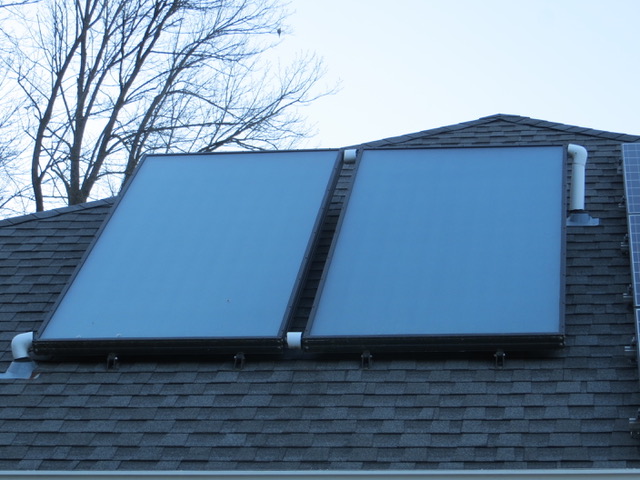
Installer & Month Year Turned On: H&H Electric installed both systems. Operation began in September 2008. H&H was selected because they could do both PV and hot water, and they offered a discount if we did both with them.
Utility Provider? MGE
Lessons Learned: As an early adopter, the system was far more expensive than they are today. I calculated the payback period as 25 years, and that was before the inverter failed. I wish we had a longer warranty on the inverters, which are, apparently, the most fragile part of the system.
A key to get me at the time was that MGE had a ten-year program to buy solar generated electricity at $0.25 per kW hour. This arrangement included a separate meter for the solar power. This produced net credit utility bills (gas and electric) for three to four months every year. I also got a Focus on Energy grant, and a Federal tax credit to help finance the purchase.
As long as I was getting the higher rate for my solar power, I was required to pay the Green Power Tomorrow add-on. When the premium ended, that was no longer required. A neighbor, who also has solar on his roof, recommended that I switch to time-of-use to pay for my power. The solar power I now sell goes by the same rules, even though I still have two meters. The net result is that solar now comes close to paying my electric bill.
When Focus on Energy contacted me about adding solar (my house was EMERGY STAR certified by them), I recognized that the house has a large expanse of roof facing due south, and that the roof has as 6-10 pitch, which is nearly ideal. (I would not have wanted to prop the panels up, or put them cross-wide for esthetic reasons.) The installation was well done, and the inverter replacement is the only work that has been done on the system since installation.
And what, if anything, would you do differently if you were to start over today? I would want a longer warranty on the inverter, because that replacement was painful in view of the long payback I have to deal with. Doing it today would be less expensive, but I would miss out on 11 and a half years of solar power, reducing the greenhouse gas load on the plane.
Willing to be contacted to share experience? Yes, email: happykarter@gmail.com or phone 608-577-9173
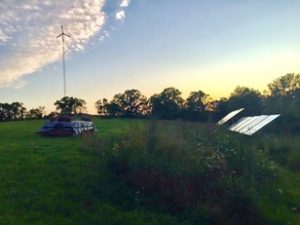
Willi Lehner and Quitas McKnight/County Road F
System: 15 kW solar array, ground mounted; 5 kW wind, 120-fott guyed tower; solar hot water, mounted; Fronius and Sunny Boy inverters; battery connected.
Installed by: Northwind Solar, Stevens Point, 2012.
Utility provider: Mt. Horeb Utility.
Lessons learned: Have an energy audit of your home done first before adding any renewables. Energy efficiency improvements are cheapest form of energy savings. Can then properly size renewable energy system to meet needs.
Willing to be contacted to learn more? Yes, at bleumont@tds.netor call 767-2875
John and Chris Coffin/North Road
System: 2.3 kW, 16 Kyroca panels, mounted on two axis trackers; 48-volt battery bank, 600 amp hours; Outback inverters; propane generator that helps heat the house. Installed 2003.
Utility provider: Off grid for 14 years; connected to Alliant in 2017.
Lessons Learned: Cost of panels has come down since 2003, so trackers are no longer useful. We use large, 2400 lbs total, lead acid batteries for storage. They still work fine, but need maintenance (check water levels) four time a year. Newer batteries are better (think Tesla power wall). There are still cost issues maintenance issues with any battery.
Willing to be contacted to learn more? Yes, at 770-6559.
SECTION 2: THE CLIMATE ACTION WORKSHOPS
Climate Action Workshop 1, Feb. 25: Actions Being Taken Now:
The first meeting was the old fashioned kind: Gather in a room together and listen and watch. We did not record it. But here are a couple of resources from it:
First, we watched portions of the film: “From Paris to Pittsburgh,” and excellent documentary about the effect of climate change across the country, and how some communities and states are stepping up to the challenges. More at https://www.paristopittsburgh.com.
Then we heard from Keith Reopelle, director of the Dane County Office of Energy and Climate, presenting highlights of the county’s far reaching and detailed Climate Action Plan. The plan was formally launched April 20. More on the Climate Action Plan at https://daneclimateaction.org + video from an earlier presentation by Reopelle here: https://youtu.be/IBjFLJyUwhg
Climate Action Workshop 2, March 31: Getting More Energy Efficient
A webinar, this time due to COVID-19. Featured results gained by Ice Age Trial Alliance in Cross Plains, The Driftless Area Historium in Mount Horeb, and Saemen Lumber in Cross Plains. Presentation of Wisconsin Focus on Energy incentives available. View the webinar: #2 Getting More Energy Efficient
Resources for improving energy efficiency:
To locate an Focus on Energy Advisor in your area, call 888-623-2146 or visit https://www.focusonenergy.com/energy-advisor-map
Links to Focus on Energy incentive catalogs –
Lighting
https://www.focusonenergy.com/sites/default/files/inline-files/2020_Lighting_Catalog_FINAL_v3.pdf
HVAC
https://www.focusonenergy.com/sites/default/files/inline-files/2020_HVAC_Plumbing_Catalog_FINAL.pdf
Climate Action Workshop 3, April 28: Adding Rewnewables
A webinar, again due to COVID-19. Featured introduction by Legacy Solar Cooperative of Madison of a Western Dane County Group Solar Buy. For residents, farms and small businesses from Vermona to Mazomanie, Cross Plains to Blue Mounts and all in between. Provides easy and quick access at a great cost for adding solar. More at https://legacysolarcoop.org. Also, David Stanfield of the Town of Vermont presented a report on efforts to have our local utilities add solar to their grid supply. View the webinar: #3 Adding Renewables
SECTION 3: GETTING STARTED LINKS
Focus on Energy: Homeowner and business energy efficiency incentives
Quick Energy Savings– 25 common sense suggestions
UW Extension Energy Programs & Energy On Wisconsin– Many resources, activities
Legacy Solar Co-op— Wisconsin-based, member-owned cooperative providing solar and energy efficiency products and services.
Wisconsin John Muir Chapter or MadiSUN– Offer group solar buy programs to reduce costs.
Climate Change Summarized in 7 Clear Charts
Have links you want to share, or to get more involved? Email Warren Gaskill
Helpful Getting Started Links
Focus on Energy: Homeowner and business energy efficiency incentives
Quick Energy Savings– 25 common sense suggestions
UW Extension Energy Programs & Energy On Wisconsin– Many resources, activities
Legacy Solar Co-op— Wisconsin-based, member-owned cooperative providing solar and energy efficiency products and services.
Wisconsin John Muir Chapter or MadiSUN– Offer group solar buy programs to reduce costs.
Climate Change Summarized in 7 Clear Charts
Have links you want to share, or to get more involved? Email Warren Gaskill
Background:
Town of Vermont Energy Action Objective
“Support current and future Town of Vermont residents adjust to a rapidly changing economy and environment, and to transition away from fossil-based fuels to more renewable energy sources.”
Three Targets Over Next Year
1) Communication and awareness building: Gather data on existing renewable energy adoption by residents, as well as interest in future renewable energy systems; share experiences of town residents already invested in renewable energy systems; sponsor events for learning about energy efficiency and renewable energy options; engage neighboring community support and action.
2) Improve energy efficiency: Aid residents in locating existing resources and incentives for homeowners and businesses to update appliances and equipment to more energy efficient, cost effective technology and to building standards that provide the quickest payback.
3) Expand renewable energy sources:
At home: Support town residents in learning more about on-site energy installation, benefits and payback potential; current 30% federal tax credit and up to $4000 rebate from WI Focus on Energy.
Our utilities: Encourage Black Earth Utility, Mt. Horeb Utility and Alliant Energy, and Madison Gas & Electric serving Town of Vermont residents to install local community solar projects if proven to reduce costs and increase reliability for local electricity service.
Town of Vermont Committee Leaders: David Stanfield, Barbara Borns, Peter Antonie, Warren Gaskill
Resolution Approved by Town Board: July 2019
